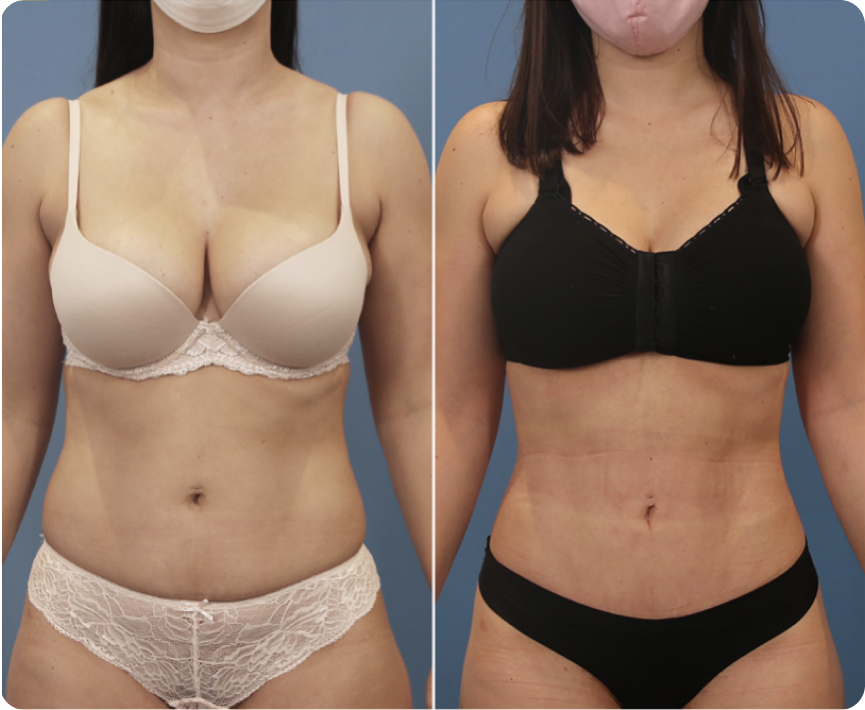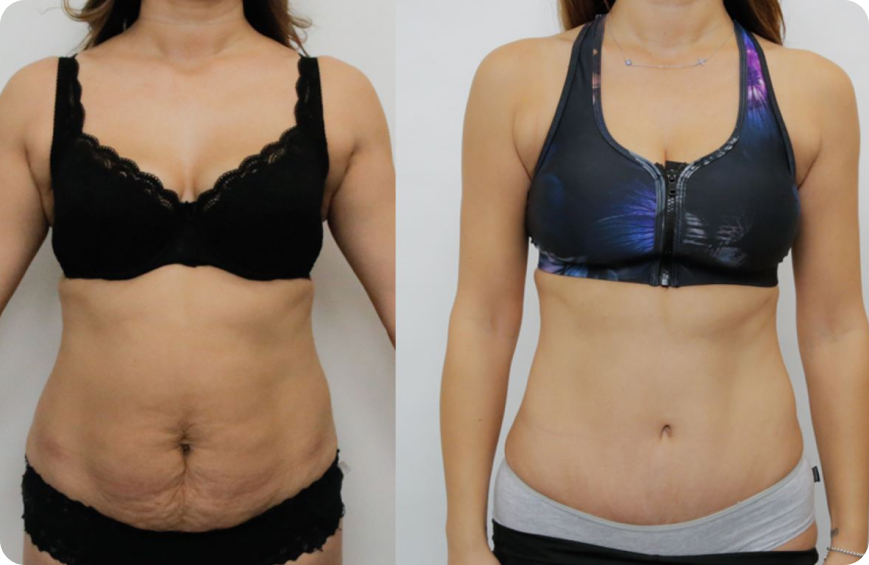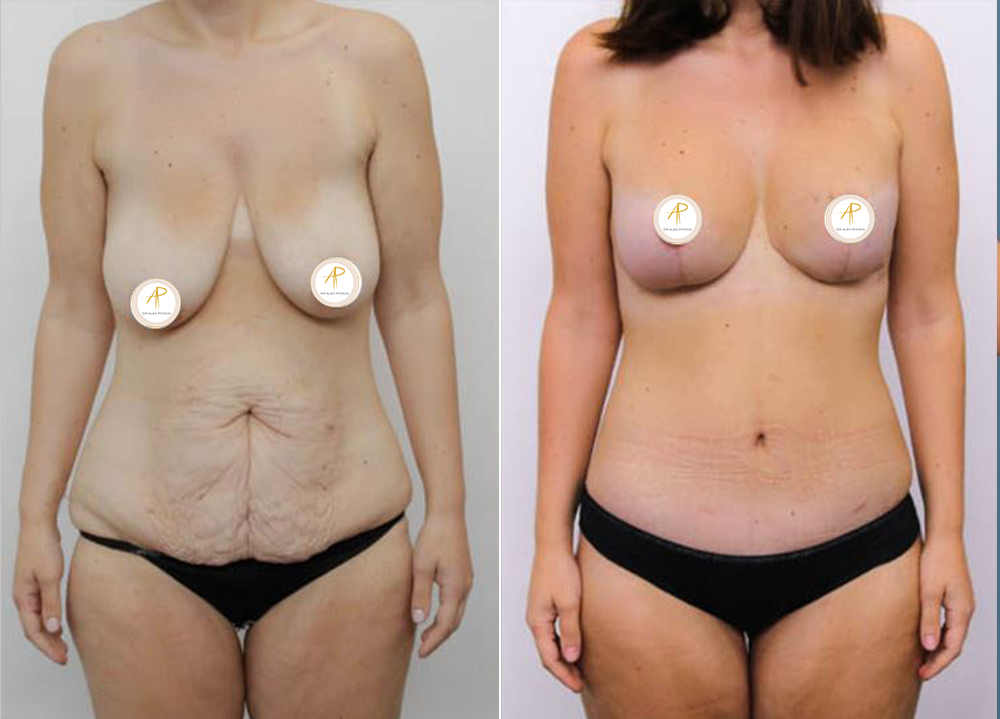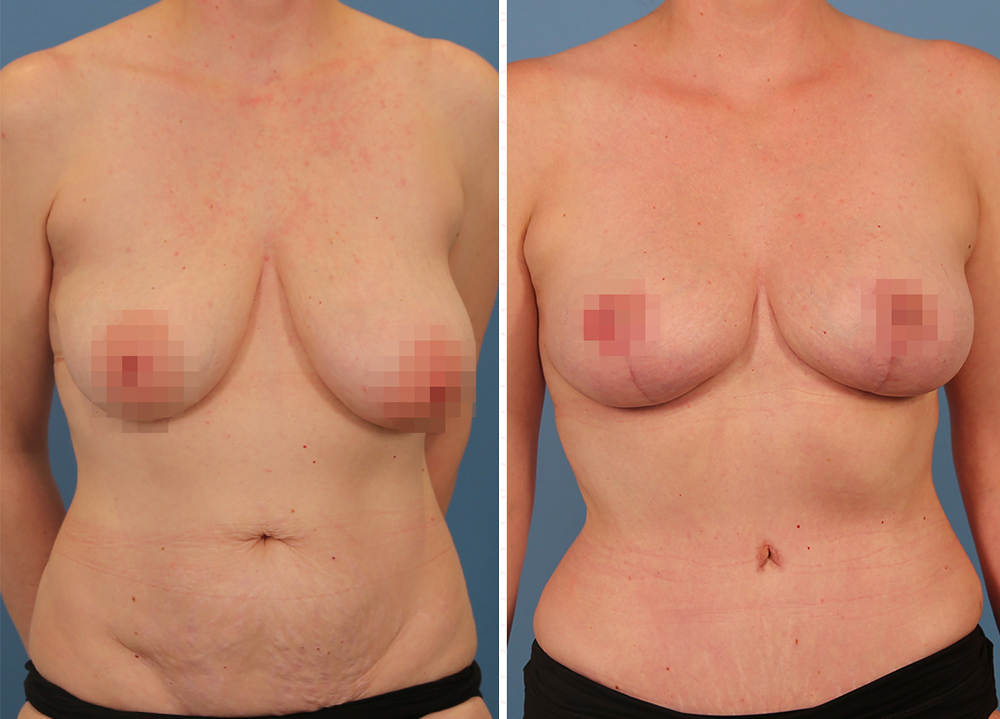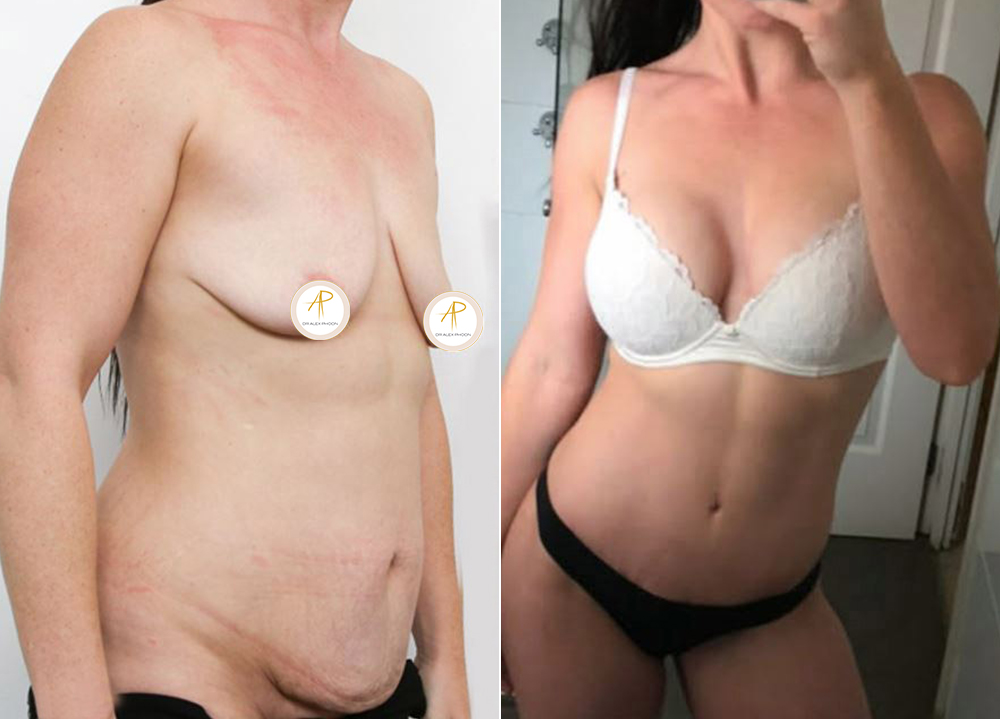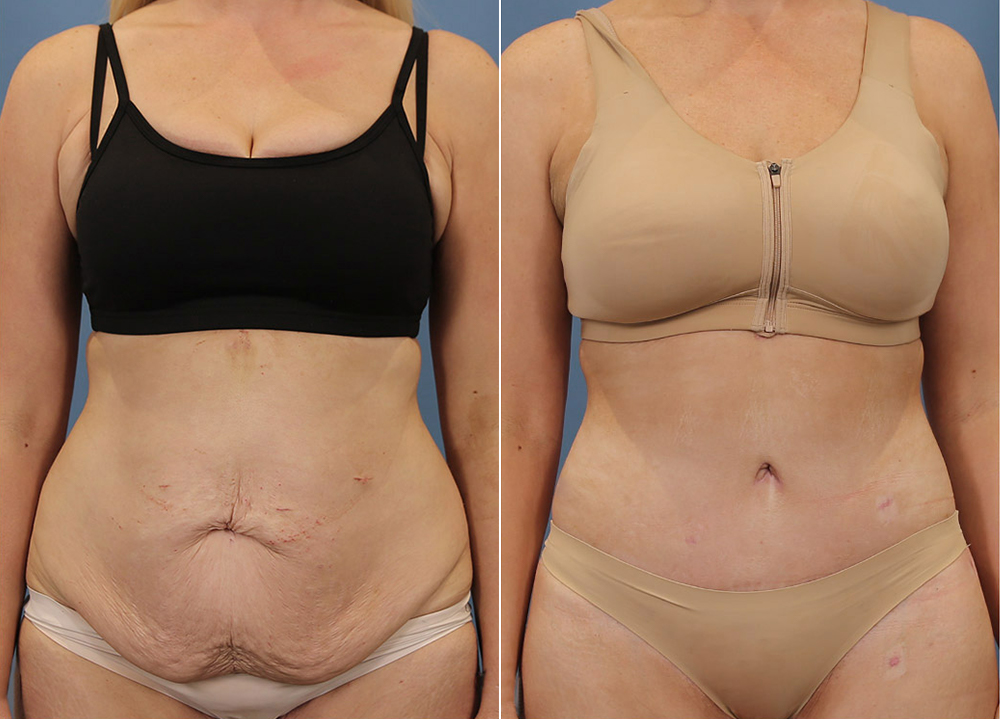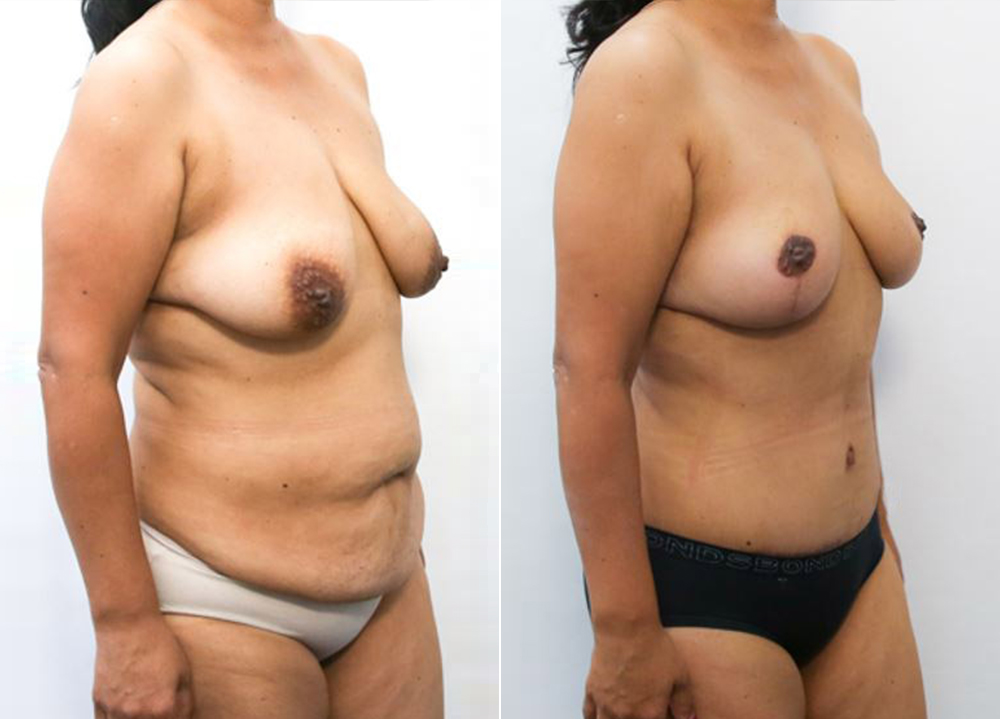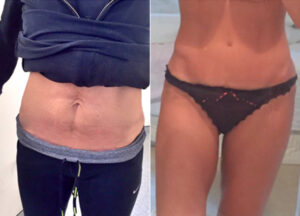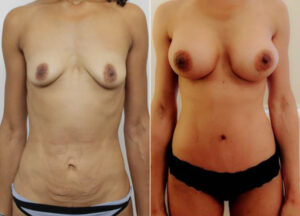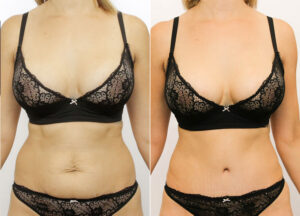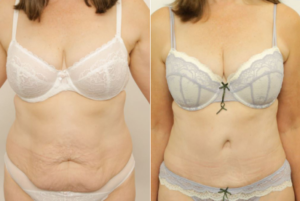
WHAT IS A TUMMY TUCK (ABDOMINOPLASTY) WITH SYDNEY PLASTIC SURGEON DR ALEX PHOON ?
An Abdominoplasty, commonly referred to as a tummy tuck, is a surgical procedure that involves the removal of excess skin from the abdominal area. This procedure also tightens the underlying core muscles.
Individuals considering abdominoplasty should be aware that it is not a substitute for weight loss through diet and exercise. Ideal candidates for the tummy tuck procedure are those who are at a stable weight but have excess skin and weakened abdominal muscles that have not responded to traditional methods.
If you’re concerned about the appearance of your
midsection and want to explore your options, it’s important to understand when an abdominoplasty in Sydney might be a suitable choice.
Depending on your needs, there are several different types of abdominoplasties that can be performed.
A consultation with Dr Alex Phoon will help you to determine which procedure is most suitable for you.

WHAT IS A MINI ABDOMINOPLASTY?
A mini abdominoplasty (mini tummy tuck Sydney) is a surgical procedure that aims to flatten and tighten the lower abdomen. This procedure is specifically designed to target the area below the belly button, making it suitable for individuals who only have minimal amounts of excess skin and fat in that area and do not require full muscle repair (diastasis recti repair). If you’re in Sydney and considering a tummy tuck, a mini abdominoplasty in Sydney might be an ideal option to discuss with your surgeon.
WHY CONSIDER AN TUMMY TUCK IN SYDNEY?
TIGHTEN MUSCLES
This patient was clearly fit before and after her surgery but illustrates what can happen when abdominal bulging post-pregnancy can be difficult to fix with simple conservative physiotherapy. Fundamentally it is a mechanical issue and fixing what is known as the ‘rectus diastasis’ with an abdominoplasty surgery can be very helpful in this regard. Note the flat abdomen that no longer bulges like a 3-month pregnancy. Also, note the belly button and scar that is hidden low down in the underwear.
EXCESS SKIN REMOVAL




Getting to your ideal weight is key to getting great results as well as a smoother post-operative recovery. Visceral fat, the fat around your organs, can only be addressed through weight loss and not surgery. This patient is a great example of how to make yourself the ideal candidate for this kind of tummy tuck surgery.
Fluctuations in weight, as well as pregnancy, can cause the skin on the stomach to lose elasticity. Once the skin is stretched, it is nearly impossible to restore its original taut appearance with exercise alone.
REMOVE SCARS




This patient had loads of loose skin and significant stretch marks that were almost completely removed with an abdominoplasty
A bonus of tummy tuck surgery is its ability to eliminate the appearance of existing scars around the midsection. Patients who have attempted to hide their c-section or hysterectomy scars beneath swimsuits may be pleased to learn that these can be reduced with an abdominoplasty Sydney. Likewise, scars resulting from appendectomy and hernia surgeries or accidents can also be reduced.
DECREASE BACK PAIN AND IMPROVE POSTURE
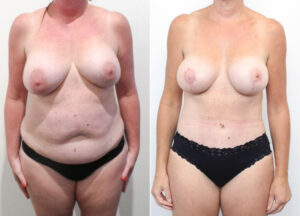


This patient had an abdominoplasty in Sydney with muscle repair as well as a breast lift with implants. If you notice some of the moles on the abdomen you can see how far the skin moves when the excess is tailored away. The patient has been fantastic here at sticking to great post-op habits like exercise and a strict diet.
Improvement in back pain symptoms can also be experienced by patients as a result of abdominoplasty in Sydney or tummy tuck in Sydney. Following the loss of a significant amount of weight or after giving birth, the stomach muscles become weak, causing some women to have back pain. By removing fat and flattening the stomach area, as well as tightening the underlying muscles during a tummy tuck Sydney, the abdomen may be better able to provide support and reduce back pain. Similarly, when back pain is eliminated and abdominal muscles are tightened, improved posture may result.
IMPROVE SELF-CONFIDENCE



This patient lost weight and had a circumferential (360) buttock graft lift procedure. A breast lift with Tiloop poc
You may feel embarrassed about the excess skin and fat that has accumulated around your midsection, or scarring from previous surgeries, which can cause your self-esteem levels to plummet. As a result, you may be less inclined to wear the latest midriff-bearing fashions or swimsuits. A tummy tuck in Sydney may go a long way toward helping you feel younger and more energetic as it restores your figure and boosts your self-confidence.
FREQUENTLY ASKED QUESTIONS ABOUT OUR ABDOMINOPLASTY PROCEDURE
It is usually best to split up the operations into pairs. The most common bundle is an initial breast/chest and tummy stage followed by an arm or thigh stage later. Although you can bundle the operations together the surgical risk and complication rates start to rise the more procedures you perform at once. By doing this in two stages it is safer, your recovery is more predictable, and it also enables potential minor adjustments to be made at the secondary procedure if needed.
Lorem ipsum dolor sit amet, consectetur adipiscing elit, sed do eiusmod tempor incididunt ut labore et dolore magna aliqua. Quis ipsum suspendisse ultrices gravida. Risus commodo viverra maecenas accumsan lacus vel facilisis.
In short yes but it is conditional. This kind of major al surgery is best performed with full insurance cover and you will need to check with our team and your fund to make sure you are covered. Usually, you need to have at least lost 5 BMI points and kept the weight off for at least 6 months to qualify. Having this surgery completely uninsured is possible too but the hospital costs can add up quickly, so we don’t advise it. Call our patient representatives and they can help you through the process.
Not really. Most Abdominoplasty can be divided into what would be considered a ‘full’ abdominoplasty or a ‘mini’ abdominoplasty. Full abdominoplasty is much more common. The ‘mini’ abdominoplasty tends to be with patients who are often quite thin and tend to have mostly loose skin and stretch marks. The belly button will often stay in exactly the same point and will not move. If you have a fair bit of excess tummy tissue it is highly likely you’ll need a full Abdominoplasty. An Abdominoplasty is not a magic bullet for weight loss- diet and exercise are still key and surgery is primarily performed for repair of muscular structures and removal of loose skin and stubborn residual fatty areas and never for weight loss.
Stretch marks are a result of rapid skin stretching. They occur when the speed of growth of the underlying body is too fast for the skin to adapt. The skin has two layers. The top layer is called the epidermis, it’s thin and can often adapt. The thicker layer underneath is called the dermis and it is composed of a tough network of collage and is responsible for the thickness or ‘toughness’ of the skin and actually tears during these times of excessive stretch. Of course the most common example of this occurs with women’s bellies during rapid growth phases during their pregnancy. All stretchmarks that are at or below the belly button are removed as part of the operation. As most stretch marks tend to be in the lower part of your tummy, an Abdominoplasty can be highly effective at improving both the contour and shape of your tummy and the texture of the skin. The resultant scar is horizontal and hidden within your underwear.
The most common procedure combined with an Abdominoplasty would have to be a breast procedure. This might be a breast augmentation, a breast reduction or even a lift with an implant (augmentation mastopexy). Like the tummy, the breast undergoes a remarkable amount of changes following breastfeeding once the breastfeeding has stopped. It is best to wait at least six months from the end of breastfeeding before considering any kind of breast surgery. Some people like to refer to this combination as a . The same can be said for massive weight loss. A stable weight near your ideal weight range is ideal. Liposuction is exactly the same thing as liposculpture and there is a lot of marketing spin out there that can make this area a particularly tricky one to understand. It really isn’t. It usually involves the use of a special device that breaks up the fat (either with a mechanical action or with ultrasound) followed by the suction process that follows it. There is always a small amount of liposuction that is performed as part of an Abdominoplasty. This is included in the price of the Abdominoplasty. For some people, the ‘gold standard’ for an Abdominoplasty might also involve some additional liposuction over the lower back, flanks, and ‘muffin top’ area as this is the most effective way to accentuate the waist and works wonders when combined with an Abdominoplasty. It is a separate procedure, however, as we have to turn you over during the procedure (whilst asleep of course) and it can take about 45 minutes to perform.
Risks and complications of cosmetic surgery
Cosmetic surgery is still surgery and as such always has potential risks and complication. It is important for anyone considering cosmetic surgery to be well-informed and aware of the possible adverse outcomes. Dr Alex Phoon is a fully qualified Australian specialist plastic and cosmetic surgeon who operates with an experienced team in leading public and private hospitals in Sydney Australia.
In this article, we will dive into the various risks and complications associated with cosmetic surgery, providing insights into each aspect.
Scarring
One of the most common concerns among patients undergoing cosmetic surgery is the potential for scarring. While skilled surgeons strive to minimize scarring, it is an inevitable part of the healing process.
Read moreThe severity of scarring varies depending on the individual and the procedure performed. Certain factors, such as genetics and skin type, can also influence how prominent scars may be. However, it is worth noting that in many cases, scars fade over time and can be further improved through scar revision techniques.
Scarring is a natural part of the body’s healing process. When the skin is injured, whether through surgery or trauma, the body responds by forming new collagen fibres to repair the damage. This process can result in the formation of a scar, which is a visible mark on the skin that differs in texture and colour from the surrounding tissue.
There are different types of scars that can occur after cosmetic surgery. One common type is a hypertrophic scar, which is characterized by raised and thickened tissue. These scars may be red or pink in colour and can be itchy or uncomfortable. Another type of scar is a keloid, which is an overgrowth of scar tissue that extends beyond the boundaries of the original wound. Keloids are more common in individuals with darker skin tones and can be more challenging to treat.
Fortunately, advancements in surgical techniques and post-operative care have greatly improved the management of scars. Surgeons take great care in placing incisions in inconspicuous areas and using techniques to minimize tension on the wound, which can help reduce the risk of visible scarring. Additionally, patients are often advised to follow a specific scar care regimen, which may include keeping the incision site clean, applying silicone gel or sheets, and avoiding sun exposure.
In some cases, scar revision techniques may be recommended to further improve the appearance of scars. These techniques can include laser resurfacing, dermabrasion, or surgical excision. Laser resurfacing uses a laser to remove the top layers of the skin, promoting the growth of new, healthier skin cells. Dermabrasion involves using a rotating brush or diamond wheel to gently remove the outer layers of the skin, revealing smoother skin underneath. Surgical excision involves removing the scar tissue and rejoining the edges of the skin to create a more aesthetically pleasing scar.
It is important for patients to have realistic expectations when it comes to scarring. While surgeons strive to minimize scarring, it is impossible to eliminate it. However, with proper care and the use of scar revision techniques, the appearance of scars can be significantly improved. Patients should discuss their concerns and expectations with their surgeon prior to undergoing any cosmetic procedure to ensure they have a clear understanding of the potential for scarring and the available treatment options.
Infection
Infections are another risk associated with any surgical procedure, including cosmetic surgery. Despite stringent sterilization protocols followed by healthcare professionals, there is still a possibility of infection.
Read moreTo mitigate this risk, surgeons prescribe antibiotics pre- and post-surgery, adhere to aseptic techniques, and closely monitor patients for signs of infection. It is crucial for patients to follow their surgeon’s aftercare instructions to minimize the risk of infection.
When it comes to cosmetic surgery, infection is a concern that cannot be ignored. Surgical procedures, no matter how minor, create an entry point for bacteria and other microorganisms. Although healthcare professionals take every precaution to maintain a sterile environment, the human body is naturally teeming with bacteria, making it impossible to eliminate the risk entirely.
Fortunately, surgeons are aware of this risk and take proactive measures to minimize the chances of infection. One such measure is the prescription of antibiotics. Prior to surgery, patients are often given a course of antibiotics to help prevent any potential infection from taking hold. These antibiotics are carefully chosen based on the patient’s medical history and the specific procedure being performed.
Post-surgery, patients are usually required to continue taking antibiotics for a certain period. This helps to ensure that any bacteria that may have entered the body during the procedure are promptly eradicated. By adhering to the prescribed antibiotic regimen, patients can significantly reduce the risk of developing an infection.
In addition to antibiotics, surgeons also follow strict aseptic techniques during the surgical procedure itself. This involves maintaining a sterile environment, using sterile instruments and equipment, and wearing appropriate protective clothing, such as gloves and masks. These precautions help to minimize the introduction of bacteria into the surgical site, further reducing the risk of infection.
Despite these measures, it is important to note that infections can still occur. The human body is a complex system, and sometimes even the most stringent precautions cannot completely eliminate the risk. However, by closely monitoring patients for signs of infection, surgeons can detect and treat any potential infections early on, preventing them from becoming serious complications.
Patients also play a crucial role in minimizing the risk of infection. Following the surgeon’s aftercare instructions is of utmost importance. This may include keeping the surgical site clean and dry, avoiding certain activities or behaviours that could increase the risk of infection, and promptly reporting any signs of infection, such as redness, swelling, or discharge.
In conclusion, while the risk of infection is present in any surgical procedure, including cosmetic surgery, healthcare professionals take numerous precautions to minimize this risk. From prescribing antibiotics to following aseptic techniques, surgeons prioritize patient safety and strive to create the best possible outcome. However, it is essential for patients to actively participate in their own aftercare and follow the instructions provided by their surgeon to further reduce the risk of infection.
Pain
Pain and discomfort is a common experience following cosmetic surgery but can be mitigated with modern analgesic strategies.
Read moreThe extent of pain can vary depending on the procedure, the individual’s pain tolerance, and the body’s healing response. Surgeons typically prescribe pain medications to manage any discomfort during the recovery period. It is important for patients to communicate their pain levels with their healthcare providers, as proper pain management is crucial for a smooth recovery.
Undesirable cosmetic outcome
While cosmetic surgery aims to enhance aesthetics, there is always a risk of an undesirable cosmetic outcome.
Read moreFactors such as unrealistic expectations and the biological unpredictability of healing can contribute to suboptimal results. It is essential for patients to have open and honest discussions with their surgeons about their desired outcomes, potential limitations, and realistic expectations. This helps ensure that both parties are on the same page and reduces the chances of disappointment. Revision surgery might be an option should this be an issue.
Nerve damage
Another potential complication of cosmetic surgery is nerve damage.
Read moreSurgeons take great care to avoid damaging nerves during procedures, but it is not always possible to eliminate this risk entirely. Nerve damage can cause numbness, tingling, or loss of sensation in the operated area. In most cases, nerve function gradually improves, but it may take some time for complete resolution. Patients should be aware of this potential risk and discuss it with their surgeon before proceeding with the surgery.
Bruising and swelling
Bruising and swelling are common after cosmetic surgery, particularly in the early stages of recovery.
Read moreThese symptoms are part of the body’s natural response to trauma. Surgeons may recommend compression garments, elevation, and cold compresses to help minimize these effects. While bruising and swelling are temporary, they can cause discomfort and can affect the recovery timeline. Patience and adherence to post-operative guidelines can aid in reducing the duration and severity of these side effects.
Bleeding
Bleeding during or after surgery is a potential complication that can occur in any surgical procedure, including cosmetic surgery.
Read moreSurgeons take measures to control bleeding during the operation, but occasionally, some post-operative bleeding may occur. It is crucial for patients to inform their healthcare providers if they experience excessive bleeding or if they are unable to control bleeding with gentle pressure. Immediate medical attention is necessary to address this complication. If there is major bleeding, you might require a blood transfer or transfer to a hospital for additional treatment.
Seroma
A seroma is a pocket of fluid that can accumulate under the skin after surgery.
Read moreIt forms as a result of the body’s inflammatory response. Seromas are more common in larger surgical procedures and can lead to swelling and discomfort. Surgeons may drain seromas through aspiration or place drains to prevent their accumulation. A surgical drain can be used to minimise this risk. Close monitoring by healthcare providers is crucial to ensure the timely detection and management of seromas.
Anaesthetic complications
Although rare, complications related to anaesthesia can occur during cosmetic surgery.
Read moreAnaesthesia is administered to ensure patient comfort and safety during the procedure. Factors such as individual reactions, allergies, or underlying health conditions can increase the risk of complications. Anaesthetists are highly trained professionals who monitor patients closely throughout the surgery to minimize any potential risks.
Death
While the risk of death from cosmetic surgery is extremely low, it is essential to acknowledge that any surgical procedure carries inherent risks.
Read moreEvery effort is made to prioritize patient safety and ensure favourable outcomes. The preoperative assessment, careful surgical planning, and adherence to appropriate protocols help minimize this risk. Patients should discuss their specific concerns with their surgical team and feel confident in the expertise and experience of their chosen surgeon.
In conclusion, cosmetic surgery offers individuals an opportunity to enhance their appearance, but it is essential to recognize that it is not without its risks and complications. By understanding and discussing these potential outcomes with their surgeons, patients can make informed decisions and take necessary precautions to optimize their safety and overall surgical experience. With proper expectations, diligent aftercare, and open communication, the risks associated with cosmetic surgery can be minimized, and the goal of achieving desired aesthetic improvements can be realized.



















